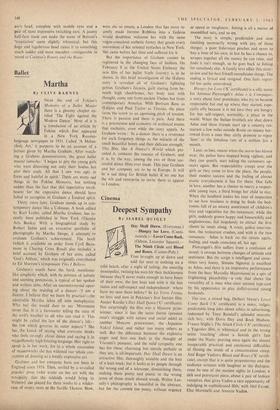Theatre
Bad Dream
By BAMBER GASCOIGNE
A Midsummer Night's Dream. (Royal Court.) A Midsummer Night's Dream ends with amateur theatricals; Tony Richardson's new pro- duction begins with them. The performance of Pyramus and Thisbe' in the court of the
buke of Athens is intended as an uproarious parody; Tony Richardson makes it a grotesque comment on society. Shakespeare's young lovers are artificial, romantic and—in intention at least —diverting; Tony Richardson's are gauche and dull.
I can see what Mr. Richardson is trying to do. He is a victim of the great modern desire for `significance'—one of the most familiar pit- falls of twentieth-century art. Faced with the euphuistic gilded youths of Shakespeare's Athens, Mr. Richardson has to prove that they are really our own modern teenagers after all; and where an ancient royal court laughs at an honest weaver's histrionics, the new Royal Court sniffs an indictment of the class structure.
Interpretation of this type can sometimes re- vive a familiar play miraculously, but it has to be done with both power and subtlety so that one responds to the effect and not to the intention; one must laugh or cry before getting the message. At the Royal Court sheer incom- petence prevents this happening. Only very skil- ful performers could blend the mannerisms of modern teenagers with the brittle quality of the verse in these speeches, but with an experienced\ company Tony Richardson's intentions might just be feasible. Instead, he takes a short cut and employs a very young cast, hoping that their natural selves will fulfil his requirements. They don't. The giggles, the shrieks, the in- coherence and the gawkiness could all be said to be true to adolescence and even to young love; but on the stage they should seem the products of art, not of amateurishness.
The same is true of the rude mechanicals, alias hempen homespuns, alias handicraft men, in their performance of the 'tedious brief scene of Pyramus and Thisbe.' Their clumsiness needs to be refined by art if it is to be anything but merely painful, but Tony Richardson just throws them together on a stage that is far too small, and lets them jostle and bump each other in their efforts to perform at all. This messiness is exactly how it might be in real life; but, as in real life, it is merely unpleasant to watch. Only a film could present the scene in this way, for in a film the camera angles and the editing can make a selection of the blunt reality and so provide the necessary art.
To make his social point Mr. Richardson exaggerates the derisive laughter of the court audience, but again his touch is so brash that the audience becomes as unwatchable as the players. In a similar scene in Michael Elliot's production of As You Like It at the Aldwych a crowd of hard-faced and Cranach-like court ladies accompany the brutalities of the wrestling match with shrill cheers. But there the wrestling is brilliantly directed, the tableau on Richard Negri's set is superb, the point is not over- stressed and, most important of all, the idea of the cruelty of court life is relevant to the whole meaning of As You Like It. In the. Dream the same point is extraneous. The players are much more eager to perform than the court is to watch them and, though the court's com- ments are frivolous and supercilious, the Duke does insist on behalf of the players that 'never anything can be amiss, When simpleness and duty tender it.' Directed with more art and less matter the scene can be funny and even de- lightful; and it is enough that it should be these things. After all, this is a midsummer night's dream—even, let it hastily be added, a pre-Freudian one.
Other elements of this production are harder to explain—the tawdry bits of stage magic, for example, which include tiny flights by a fairy and by a large cloth of silk on brightly gleaming wires: or Tony Richardson's apparent deter- mination to do everything possible to distract attention from the poetry. Puck's first scene is almost a parody of bad directing. The flying fairy effectively nullifies the first half, and as soon as the little creature is safely grounded he and Puck set about ruining the remaining speeches by tobogganing up and down a hillock. It is only in the rehearsal scenes by the handicraft men —led by Colin Blakely as an excellent bully Bottom—that the production comes convincingly to life. Jocelyn Herbert has designed a superb ass's head, complete with mobile eyes and a pair of most expressive twitching ears. A jaunty half-face mask can make the scene of Bottom's 'translation' seem slightly whimsical, but this huge and lugubrious head raises it to something much sadder and more macabre—comparable in 'mood to Cocteau's Beauty and the Beast.-



































 Previous page
Previous page